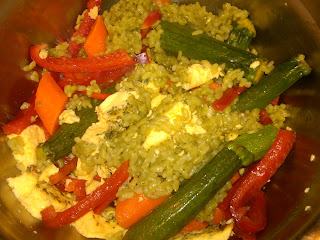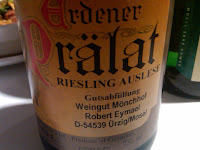And so it was, that on a Tuesday a few weeks ago, that yours truly plus eight others descended upon
Apiary to help relieve a friend of several 22-year old Burgundies.
1988 was the year that construction on the pyramid at the Louvre began, and also considered an excellent year for Burgundy. Many critics said the weather that year produced healthy grapes overall, though structures were firm and would need time to soften. Perfect! Overall, I think these wines are enjoyable now, and in some cases (choose your producer carefully), have some more time to go.
I’d be negligent to not mention that Apiary runs a free-corkcage on Monday night. The restaurant has a very wine-friendly menu (the chef was brought over from
Veritas) and includes a $35, three-course pre-fixe menu too. I think it’s an excellent place to take a first date. Especially if she’s a redhead.
After we dispensed with a bottle of Champagne, here’s what we drank:
Prince de Florent Merode, ‘Le Marechaudes’ (Corton)Started off slow with a wine that was pleasant enough, but started to shut-down after 15 minutes. It was of medium intensity showing all the characteristics of a red Burgundy (dried cherry, forest floor, some white pepper) before it closed up, never to recover. It was past its prime.
Turns out this house is known for making wines that are meant to be consumed immediately (a restaurant wine). They don’t macerate on the skins and only press gently so that the emphasis is on fresh fruit and no bitter tannins.
About Corton: like Chablis, it’s a Grand Cru divided into a collection of climates (including Marechaudes). When Chardonnay is planted here it’s called Corton-Charlemagne.
Don’t you love Burgundy?
Prince de Florent Merode, ‘Clos du Roi’ (Corton)This wine displayed much more brooding earthiness, structure, and the fruit was holding up much better than in the Marechaudes. Clos du Roi has a better sun exposure and more lava in the soils.

Comte Armand (Domaine du Clos des Epeneaux), ‘Clos des Epeneaux’ 1er Cru (Pommard)
Medium-intensity with relatively youthful red and blue fruits and a slight amount of wet earthiness. The structure was very well resolved. This wine was a favorite by most of the crowd.
In the 1980s when this wine was made, the domaine only made this one 1er cru (since the 1850s really) and that’s why it adopted the name (kinda like Clos de Tart in the Cotes de Nuits). As they don’t have much to work with, the grapes are harvested by the age of the vine (so, 5-10 years old, 10-20 years old) and vinified separately like that. Later the lots are blended to make their one bottling. Today they own many more properties.
‘Clos des Epeneaux’ is not on many maps because it straddles ‘Les Grand Epenots’ and ‘Les Petits Epenots’.
Marquis d’Angerville, ‘Clos des Ducs’ 1er Cru (Volnay)
Marquis has always sounded more regal to me than king or emperor, and it’s fitting that this is one of the most respected domaines in Burgundy. Most of the domaine’s holdings are in Volnay with this and ‘Champans’ 1er Cru the largest parcels. I see these wines on many restaurant’s lists.
The wine was a little more shy than the last few but had a strong forest floor component that I love, and a gorgeous velvet texture on the palate.
Joseph Drouhin (Latrecieres-Chambertin)
A little dank but otherwise dark fruits, sweet red fruits, and a slight minerality. A touch on the too-advanced side, but not a total waste of time.
Drouhin owns many vineyards throughout Burgundy (and Oregon) and is also a negotiant. I find the wines to be honest and reliable, maybe occasionally exciting, but I think it’s an easy house to buy. Latrecieres-Chambertin is a negotiant bottling.

Domaine Louis Trapet (Latrecieres-Chambertin)
Compared to the Drouhin, this was a more youthful and expressive Latrecieres. Red cherry, earthiness, and even gaminess made this wine complex.
Trapet has been around for many generations, and I find the wines to be a consistently good.
Domaine Dujac (Echezeaux)
Ah, Dujac. I can count on the wines from this house to be rather powerful (for Burgundy). I believe this is due to a combination of waiting for ripe grapes and use of 100% new French oak on all 1er Crus and Grand Crus. At 22 years old, this wine was still singing.
Aromas included strawberries, blackberries, red flowers, wet earth, and baking spices. The length held on to fruit and acid, and went on forever and ever.
Domaine Dujac (Clos de la Roche)
I adore Morey-Saint-Denis, but have been only lukewarm on Clos de la Roche Grand Cru. Despite this, this was one of my favorite wines of the night. This vineyard catches a lot of sun, and, as the name suggests, is on very poor, rocky soils, so we might see more concentrated grapes. Maybe I just drink Clos de la Roche too young?
This wine displayed wonderful red and dark fruits, with baking spices, stones, damp earth, and a savory aspect. Palate is velvetly and still showing bright acidity.
 Domaine de la Romanee-Conti (Richebourg)
Domaine de la Romanee-Conti (Richebourg)DRC, the holy grail of Burgundy, did not fail me. Do you know the feeling I’m talking about? If this wine was not spectacular, I probably would have sold my whole cellar for charity and become a bingo-announcer for a retirement community in south Florida.
This wine was just gorgeous. Cherries and figs, exotic spice box, forest floor, roses, soy sauce, a length that went for a long time displaying all those elements again. The structure was a whisper on the firm side, just enough to suggest that this wine still has a long, healthy life ahead of it.
A moment to reflect on happiness please.
OK, last wine of the night:
Mongeard-Mugneret (Richebourg)Tough coming on the heels of DRC but still a beautifully expressive wine. The difference here was that fruit was more cherry and cranberry, plenty of dank earthiness, and baking spices didn’t seduce the way the DRC did. This wine was still plenty ripe and drinking beautifully, and is worth searching out.
This domaine owns a lot of parcels throughout Burgundy with Richebourg being one of the smallest holdings. We were blinded on the Echezeaux later but I failed to write down any notes. Sorry.
Domaine Leroy (Richebourg)I lied. We had one more wine. But it was off. Doesn't count, though I have hit-or-miss with Leroy, so I was really looking forward to this one.


































 I ordered a glass of the 1995 Merlot from Gristina out of morbid curiosity:
I ordered a glass of the 1995 Merlot from Gristina out of morbid curiosity: 



 Domaine de la Romanee-Conti (Richebourg)
Domaine de la Romanee-Conti (Richebourg)




 Somebody’s Niersteiner Pettental Riesling Beerenauslese 1976 (Rheinhessen), $NA, 8% abv
Somebody’s Niersteiner Pettental Riesling Beerenauslese 1976 (Rheinhessen), $NA, 8% abv



